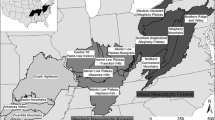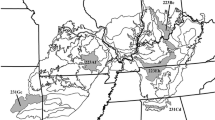Abstract
Context
Forest landscape models (FLMs) are important tools for simulating forest changes over broad spatial and temporal scales. The ability of FLMs to accurately predict forest changes may be significantly influenced by the formulations of site-scale processes including seedling establishment, tree growth, competition, and mortality.
Objective
The objectives of this study were to investigate the effects of site-scale processes and interaction effects of site-scale processes and harvest on landscape-scale forest change predictions.
Methods
We compared the differences in species’ distribution (quantified by species’ percent area), total aboveground biomass, and species’ biomass derived from two FLMs: (1) a model that explicitly incorporates stand density and size for each species age cohort (LANDIS PRO), and (2) a model that explicitly tracks biomass for each species age cohort (LANDIS-II with biomass succession extension), which are variants from the LANDIS FLM family with different formulations of site-scale processes.
Results
For early successional species, the differences in simulated distribution and biomass were small (mostly less than 5 %). For mid- to late-successional species, the differences in simulated distribution and biomass were relatively large (10–30 %). The differences in species’ biomass predictions were generally larger than those for species’ distribution predictions. Harvest mediated the differences on landscape-scale predictions.
Conclusions
The effects of site-scale processes on landscape-scale forest change predictions are dependent on species’ ecological traits such as shade tolerance, seed dispersal, and growth rates.









Similar content being viewed by others
References
Aber JD, Ollinger SV, Federer CA, Reich PB, Goulden ML, Kicklighter DW, Melillo JM, Lathrop RG (1995) Predicting the effects of climate change on water yield and forest production in the northeastern United States. Climate Res 5(3):207–222
Bu R, He HS, Hu Y, Chang Y, Larsen DR (2008) Using the LANDIS model to evaluate forest harvesting and planting strategies under possible warming climates in Northeastern China. For Ecol Manag 254(3):407–419
Burns RM, Honkala B (1990) Silvics of North America: 1. Conifers; 2. Hardwoods. Agriculture Handbook 654, USDA Forest Service, Washington, DC.
Condit R, Ashton P, Bunyavejchewin S, Dattaraja HS, Davies S, Esufali S, Ewango C, Foster R, Gunatilleke I, Gunatilleke C, Hall P, Harms K, Hart T, Hernandez C, Hubbell S, Itoh A, Kiratiprayoon S, LaFrankie J, de Lao S, Makana J, Noor M, Kassim AR, Russo S, Sukumar R, Samper C, Suresh HS, Tan S, Thomas S, Valencia R, Vallejo M, Villa G, Zillio T (2006) The importance of demographic niches to tree diversity. Science 313(5783):98–101
Dalling JW, Hubbell SP (2002) Seed size, growth rate and gap microsite conditions as determinants of recruitment success for pioneer species. J Ecol 90(3):557–568
Elkin C, Reineking B, Bigler C, Bugmann H (2012) Do small-grain processes matter for landscape scale questions? Sensitivity of a forest landscape model to the formulation of tree growth rate. Landscape Ecol 27(5):697–711
Feng Z, Wang X, Wu G (1999) Biomass and productivity of forest ecoystems in China. Science Press, Beijing
Fraser JS, He HS, Shifley SR, Wang WJ, Thompson FR (2013) Simulating stand-level harvest prescriptions across landscapes: LANDIS PRO harvest module design. Can J For Res 43(10):972–978
Gross KL (1984) Effects of seed size and growth form on seedling establishment of six monocarpic perennial plants. J Ecol 72(2):369–387
Gustafson EJ, Shifley SR, Mladenoff DJ, Nimerfro KK, He HS (2000) Spatial simulation of forest succession and timber harvesting using LANDIS. Can J For Res 30(1):32–43
Gustafson EJ, Shvidenko AZ, Sturtevant BR, Scheller RM (2010) Predicting global change effects on forest biomass and composition in south-central Siberia. Ecol Appl 20(3):700–715
He HS (2008) Forest landscape models: Definitions, characterization, and classification. For Ecol Manag 254(3):484–498
He HS, Hao ZQ, Mladenoff DJ, Shao GF, Hu YM, Chang Y (2005) Simulating forest ecosystem response to climate warming incorporating spatial effects in north-eastern China. J Biogeogr 32(12):2043–2056
He HS, Mladenoff DJ (1999) The effects of seed dispersal on the simulation of long-term forest landscape change. Ecosystems 2(4):308–319
Howe HF, Schupp EW, Westley LC (1985) Early consequences of seed dispersal for a neotropical tree (Virola surinamensis). Ecology 66(3):781–791
Hu HQ, Luo BZ, Wei SJ, Wei SW, Sun L, Luo SS, Ma HB (2015) Biomass carbon density and carbon sequestration capacity in seven typical forest types of the Xiaoxing’an Mountains, China. Chin J Plant Ecol 39:140–158
Jenkins JC, Chojnacky DC, Heath LS, Birdsey RA (2004) Comprehensive database of diameter-based biomass regressions for North American tree species. Gen. Tech. Rep. NE-319. U.S. Department of Agriculture, Forest Service, Northeastern Research Station, Newtown Square
Keane RE, Cary GJ, Davies ID et al (2004) A classification of landscape fire succession models: spatial simulations of fire and vegetation dynamics. Ecol Model 179(1):3–27
Li H, Lei Y (2010) Estimation and evaluation of forest biomass carbon storage in China. China Forestry Press, Beijing
Liang Y, He HS, Wang WJ, Fraser JS, Wu Z, Xu J (2015) The site-scale processes affect species distribution predictions of forest landscape models. Ecol Model 300:89–101
Lischke H, Zimmermann NE, Bolliger J, Rickebusch S, Löffler TJ (2006) TreeMig: A forest-landscape model for simulating spatio-temporal patterns from stand to landscape scale. Ecol Model 199(4):409–420
Loewenstein EF, Johnson PS, Garrett HE (2000) Age and diameter structure of a managed uneven-aged oak forest. Can J For Res 30(7):1060–1070
Löffler TJ, Lischke H (2001) Incorporation and influence of variability in an aggregated forest model. Nat Resour Model 14(1):103–137
Long JN (1985) A practical approach to density management. For Chron 61(1):23–27
Luo X, He HS, Liang Y, Wang WJ, Wu Z, Fraser JS (2014) Spatial simulation of the effect of fire and harvest on aboveground tree biomass in boreal forests of Northeast China. Landscape Ecol 29(7):1187–1200
Luo Y, Wang X, Zhang X, Lu F (2013) Biomass and Its Allocation of Forest Ecosystems in China. China Forestry Press, Beijing
Miehle P, Livesley SJ, Li C, Feikema PM, Adams MA, Arndt SK (2006) Quantifying uncertainty from large-scale model predictions of forest carbon dynamics. Glob Chang Biol 12(8):1421–1434
Mladenoff DJ, He HS (1999) Design and behaviour of LANDIS, an object-oriented model of forest landscape disturbance and succession. In: Mladenoff DJ, Baker WL (eds) Advances in spatial modeling of forest landscape change: approaches and applications. Cambridge University Press, Cambridge, UK, pp 125–162
Moorcroft PR, Hurtt GC, Pacala SW (2001) A method for scaling vegetation dynamics: the ecosystem demography model(ED). Ecol Mono 71(4):557–586
Murphy PA, Graney DL (1998) Individual-tree basal area growth, survival, and total height models for upland hardwoods in the Boston Mountains of Arkansas. S J Appl For 22(3):184–192
Oliver CD, Larson BC (1996) Forest Stand dynamics, Update edn. Wiley, New York
Paz H, Mazer SJ, Martínez-Ramos M (1999) Seed mass, seedling emergence, and environmental facts in seven rain forest psychotria(Rubiaceae). Ecology 80(5):1594–1606
Perry GLW, Enright NJ (2006) Spatial modelling of vegetation change in dynamic landscapes: a review of methods and applications. Prog Phys Geogr 30(1):47–72
R Development Core Team (2011) R: a language and environment for statistical computing. R Development Core Team, Vienna
Reineke LH (1933) Perfecting a stand-density index for even-aged forest. J Agric Res 46:627–638
Romme WH, Everham EH, Frelich LE, Moritz MA, Sparks RE (1998) Are large, infrequent disturbances qualitatively different from small, frequent disturbances? Ecosystems 1(6):524–534
Scheller RM, Domingo JB, Sturtevant BR, Williams JS, Rudy A, Gustafson EJ, Mladenoff DJ (2007) Design, development, and application of LANDIS-II, a spatial landscape simulation model with flexible temporal and spatial resolution. Ecol Model 201(3–4):409–419
Scheller RM, Miranda B (2015) LANDIS-II Biomass Succession v3.2 Extension User Guide, p 5
Scheller RM, Mladenoff DJ (2004) A forest growth and biomass module for a landscape simulation model, LANDIS: design, validation, and application. Ecol Model 180(1):211–229
Scheller RM, Mladenoff DJ (2005) A spatially interactive simulation of climate change, harvesting, wind, and tree species migration and projected changes to forest composition and biomass in northern Wisconsin, USA. Glob Chang Biol 11(2):307–321
Scheller RM, Mladenoff DJ (2007) An ecological classification of forest landscape simulation models: tools and strategies for understanding broad-scale forested ecosystems. Landscape Ecol 22(4):491–505
Scheller RM, Van Tuyl S, Clark K, Hom J, La Puma I (2011) Carbon sequestration in the New Jersey pine barrens under different scenarios of Fire management. Ecosystems 14(6):987–1004
Schumacher S, Bugmann H, Mladenoff DJ (2004) Improving the formulation of tree growth and succession in a spatially explicit landscape model. Ecol Model 180(1):175–194
Seidl R, Rammer W, Scheller RM, Spies TA (2012) An individual-based process model to simulate landscape-scale forest ecosystem dynamics. Ecol Model 231:87–100
Taylor AR, Chen HYH, VanDamme L (2009) A review of forest succession models and their suitability for forest management planning. For Sci 55(1):23–36
Thompson JR, Foster DR, Scheller RM, Kittredge D (2011) The influence of land use and climate change on forest biomass and composition in Massachusetts, USA. Ecol Appl 21:2425–2444
Tripathi RS, Khan ML (1990) Effects of seed weight and microsite characteristics on germination and seedling fitness in two species of Quercus in a subtropical wet hill forest. Oikos 57(3):289–296
Turnbull LA, Rees M, Crawley MJ (1999) Seed mass and the competition/colonization trade-off: a sowing experiment. J Ecol 87(5):899–912
Turner MG (2010) Disturbance and landscape dynamics in a changing world. Ecology 91(10):2833–2849
Wang WJ, He HS, Fraser JS, Thompson FR, Shifley SR, Spetich MA (2014a) LANDIS PRO: a landscape model that predicts forest composition and structure changes at regional scales. Ecography 37:225–229
Wang WJ, He HS, Spetich MA, Shifley SR, Thompson FR, Dijak WD, Wang Q (2014b) A framework for evaluating forest landscape model predictions using empirical data and knowledge. Environ Model Softw 62:230–239
Wang WJ, He HS, Spetich MA, Shifley SR, Thompson FR, Larsen DR, Fraser JS, Yang J (2013) A large-scale forest landscape model incorporating multi-scale processes and utilizing forest inventory data. Ecosphere 4(9):106–117
Wang WJ, He HS, Thompson FR, Fraser JS (2016) Changes in forest biomass and tree species distribution under climate change in the Northeastern United States. Landscape Ecol. doi:10.1007/s10980-016-0429-z
Wang WJ, He HS, Thompson FR, Fraser JS, Dijak WD (2015a) Landscape- and regional-scale shifts in forest composition under climate change in the Central Hardwood Region of the United States. Landscape Ecol 31(1):149–163
Wang WJ, He HS, Thompson FR, Fraser JS, Hanberry BB, Dijak WD (2015b) Importance of succession, harvest, and climate change in determining future forest composition changes in U.S. Central Hardwood Forests. Ecosphere 6(12):277
Ward BC, Mladenoff DJ, Scheller RM (2005) Landscape-level effects of the interaction between residential development and public forest management in northern Wisconsin, USA. For Sci 51:616–632
Xu C, Gertner GZ, Scheller RM (2009) Uncertainties in the response of a forest landscape to global climatic change. Glob Chang Biol 15(1):116–131
Yan X, Shugart HH (2005) FAREAST: a forest gap model to simulate dynamics and patterns of eastern Eurasian forests. J Biogeogr 32(9):1641–1658
Yoda K, Kira T, Ogawa H, Hozumi K (1963) Self-thinning in overcrowded pure stands under cultivated and natural conditions. J Biol 14:107–129
Acknowledgments
This research was funded by Chinese National Science Foundational Project 31570461, 31300404 and 41371199 and University of Missouri GIS Mission Enhancement Program. JT’s time was supported through NSF LTER Grant No. NSF-DEB 12-37491.
Author information
Authors and Affiliations
Corresponding author
Electronic supplementary material
Below is the link to the electronic supplementary material.
Rights and permissions
About this article
Cite this article
Xiao, J., Liang, Y., He, H.S. et al. The formulations of site-scale processes affect landscape-scale forest change predictions: a comparison between LANDIS PRO and LANDIS-II forest landscape models. Landscape Ecol 32, 1347–1363 (2017). https://doi.org/10.1007/s10980-016-0442-2
Received:
Accepted:
Published:
Issue Date:
DOI: https://doi.org/10.1007/s10980-016-0442-2




